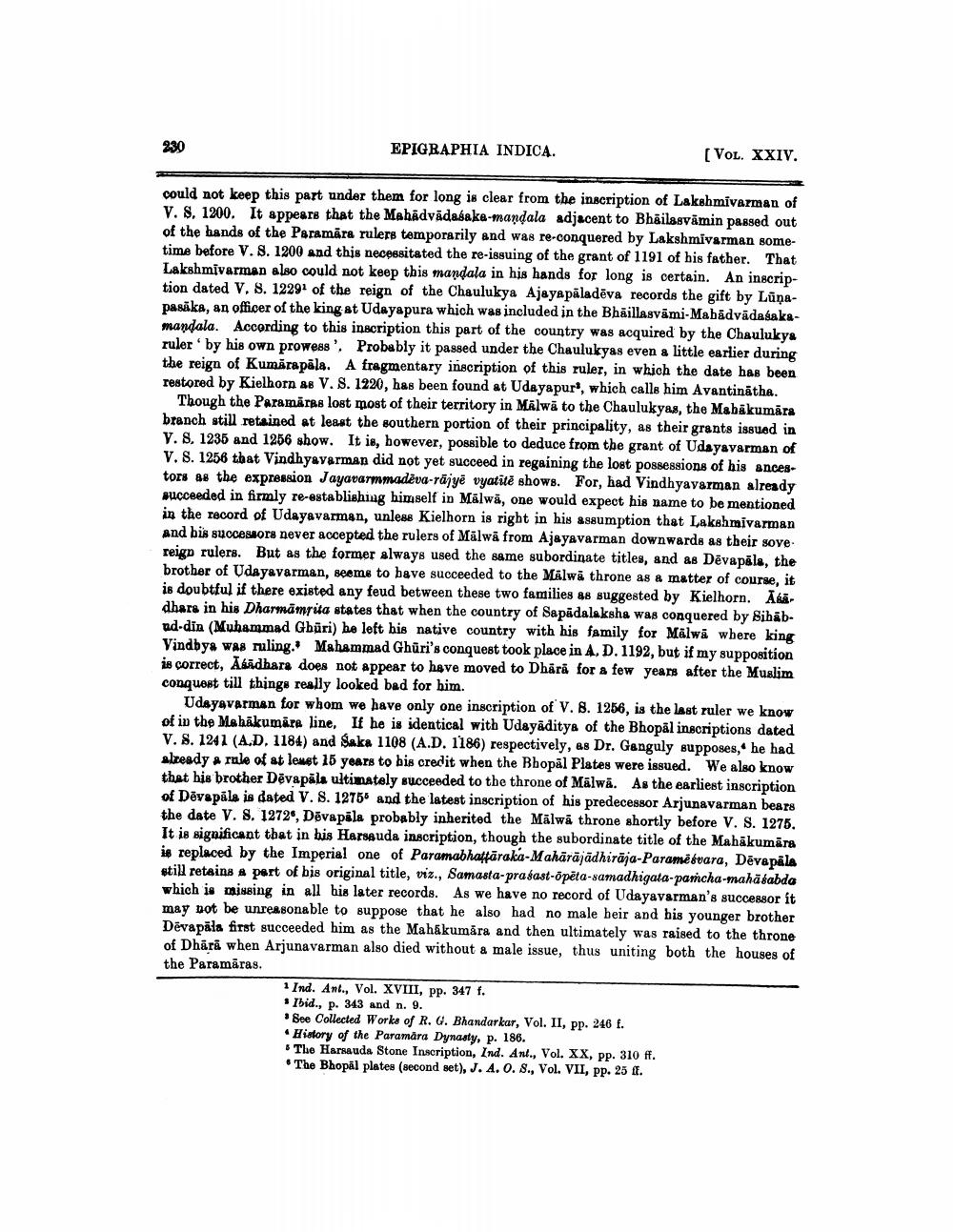________________
230
EPIGRAPHIA INDICA.
could not keep this part under them for long is clear from the inscription of Lakshmivarman of V. S. 1200. It appears that the Mahadvadasaka-mandala adjacent to Bhailasvamin passed out of the hands of the Paramara rulers temporarily and was re-conquered by Lakshmivarman sometime before V. S. 1200 and this necessitated the re-issuing of the grant of 1191 of his father. That Lakshmivarman also could not keep this mandala in his hands for long is certain. An inscription dated V. S. 12291 of the reign of the Chaulukya Ajayapaladeva records the gift by Lūņapasaka, an officer of the king at Udayapura which was included in the Bhaillasvami-Mahādvādasakamandala. According to this inscription this part of the country was acquired by the Chaulukya ruler by his own prowess'. Probably it passed under the Chaulukyas even a little earlier during the reign of Kumarapala. A fragmentary inscription of this ruler, in which the date has been restored by Kielhorn as V. S. 1220, has been found at Udayapur3, which calls him Avantinatha.
Though the Paramaras lost most of their territory in Malwa to the Chaulukyas, the Mahākumāra branch still retained at least the southern portion of their principality, as their grants issued in V. S. 1235 and 1256 show. It is, however, possible to deduce from the grant of Udayavarman of V. S. 1256 that Vindhyavarman did not yet succeed in regaining the lost possessions of his ancestors as the expression Jayavarmmadeva-rajye vyatite shows. For, had Vindhyavarman already succeeded in firmly re-establishing himself in Malwa, one would expect his name to be mentioned in the record of Udayavarman, unless Kielhorn is right in his assumption that Lakshmivarman and his successors never accepted the rulers of Malwa from Ajayavarman downwards as their sove reign rulers. But as the former always used the same subordinate titles, and as Devapala, the brother of Udayavarman, seems to have succeeded to the Malwa throne as a matter of course, it is doubtful if there existed any feud between these two families as suggested by Kielhorn. Ää dhars in his Dharmämrita states that when the country of Sapädalaksha was conquered by Sihabud-din (Muhammad Ghüri) he left his native country with his family for Malwa where king Vindbya was ruling. Mahammad Ghuri's conquest took place in A. D. 1192, but if my supposition is correct, Asadhara does not appear to have moved to Dhara for a few years after the Muslim conquest till things really looked bad for him.
[VOL. XXIV.
Udayavarman for whom we have only one inscription of V. 8. 1256, is the last ruler we know of in the Mahākumāra line, If he is identical with Udayaditya of the Bhopal inscriptions dated V. S. 1241 (A.D. 1184) and Saka 1108 (A.D. 1186) respectively, as Dr. Ganguly supposes, he had already a rule of at least 15 years to his credit when the Bhopal Plates were issued. We also know that his brother Devapala ultimately succeeded to the throne of Malwa. As the earliest inscription of Devapala is dated V. S. 12755 and the latest inscription of his predecessor Arjunavarman bears the date V. S. 1272, Devapala probably inherited the Malwa throne shortly before V. S. 1275. It is significant that in his Harsauda inscription, though the subordinate title of the Mahākumāra is replaced by the Imperial one of Paramabhattaraka-Mahārājādhiraja-Parameévara, Devapala still retains a part of his original title, viz., Samasta-prasast-õpeta-samadhigata-pamcha-mahāśabda which is missing in all his later records. As we have no record of Udayavarman's successor it may not be unreasonable to suppose that he also had no male heir and his younger brother Devapala first succeeded him as the Mahākumāra and then ultimately was raised to the throne of Dhara when Arjunavarman also died without a male issue, thus uniting both the houses of the Paramāras.
1 Ind. Ant., Vol. XVIII, pp. 347 f. Ibid., p. 343 and n. 9.
See Collected Works of R. G. Bhandarkar, Vol. II, pp. 246 f.
History of the Paramara Dynasty, p. 186.
The Harsauda Stone Inscription, Ind. Ant., Vol. XX, pp. 310 ff.
The Bhopal plates (second set), J. A. O. S., Vol. VII, pp. 25 ft.




